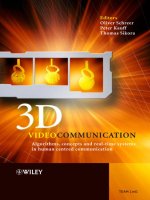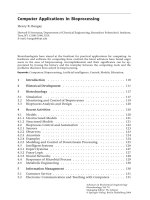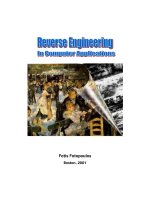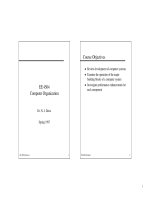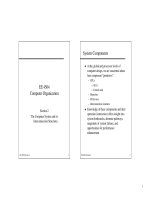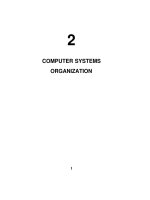Computer concepts chapter02
Bạn đang xem bản rút gọn của tài liệu. Xem và tải ngay bản đầy đủ của tài liệu tại đây (4.5 MB, 67 trang )
Chapter 2
Computer Hardware
Computer Concepts
2012
2 Chapter Contents
Section A: Personal Computer Basics
Section B: Microprocessors and Memory
Section C: Storage Devices
Section D: Input and Output Devices
Section E: Hardware Security
Chapter 2: Computer Hardware
2
2 FastPoll True/False Questions
Answer A for True and B for False
020100 A netbook is a scaled-down version of a
standard notebook computer.
020200 Small business computers have better sound
and graphics capabilities than home or game
computers.
020300 PCs, Macs, and Linux are three computer
platforms.
020400 Today’s Macs can be configured to run
Windows.
020500 Pentium, Core, Atom, and Athlon are types of
microprocessors.
Chapter 2: Computer Hardware
3
2 FastPoll True/False Questions
Answer A for True and B for False
020600 Today’s computers typically process 8 bits
at a time.
020700 Serial processing is when a processor
begins executing one instruction before it completes
the previous instruction.
020800 In RAM microscopic electronic parts called
capacitors hold the bits that represent data.
020900 ROM is a type of memory that holds the
computer’s startup routine.
Chapter 2: Computer Hardware
4
2 FastPoll True/False Questions
Answer A for True and B for False
021000 Hard disk drives, optical drives, and solid
state drives are random access devices.
021100 CD-RWs allow you to record data, but data
cannot be changed once it is recorded.
021200 VGA, SVGA, and WUXGA are examples of
screen resolutions.
021300 A surge strip allows you to use your desktop
computer during a power outage.
Chapter 2: Computer Hardware
5
2
SECTION
A
Personal Computer Basics
Personal Computer Systems
Desktop and Portable Computers
Home, Game, and Small Business Systems
Buying Computer System Components
Chapter 2: Computer Hardware
6
2 Question
022100 In the interest of being ecological, many consumers
consider upgrading their computers instead of disposing of
them and buying a new one. Which one of the following
upgrades is best left to professional technicians?
– A. Replacing the microprocessor with a newer model
– B. Adding an external hard drive for backup
– C. Swapping out a graphics card for a more powerful one
– D. Adding RAM
Chapter 2: Computer Hardware
7
2 Personal Computer Systems
Chapter 2: Computer Hardware
8
2 Desktop and Portable Computers
The term form factor refers
to the size and dimensions
of a component, such as a
system board or system
unit
A desktop computer fits on
a desk and runs on power
from an electrical wall outlet
Chapter 2: Computer Hardware
9
2 Desktop and Portable Computers
A portable computer is a small, lightweight personal
computer
A notebook computer (also referred to as a laptop), is a
small, lightweight portable computer that opens like a
clamshell to reveal a screen and keyboard
A netbook offers even more portability than a standard
computer
A tablet computer is a portable computing device featuring a
touch-sensitive screen that can be used as a writing or
drawing pad
– Slate tablet
Chapter 2: Computer Hardware
10
2 Desktop and Portable Computers
Chapter 2: Computer Hardware
11
2
Home, Game,
and Small Business Systems
A home computer system offers a computer configuration
designed to accommodate consumers who use computers
for personal tasks
Some of the most cutting-edge computers are designed for
gaming
Computers marketed for small business applications tend to
be middle-of-the-line models pared down to essentials
Chapter 2: Computer Hardware
12
2
Buying Computer
System Components
Browse through computer magazines and online computer
stores to get a general idea of features and prices
Decide on a budget and stick to it
Make a list of the ways you plan to use your computer
Select a platform
Decide on a form factor
Select peripherals, software, and accessories
Chapter 2: Computer Hardware
13
2
Buying Computer
System Components
Instead of buying a new computer, you might consider
upgrading
Chapter 2: Computer Hardware
14
2
SECTION
B
Microprocessors and Memory
Microprocessor Basics
Today’s Microprocessors
Random Access Memory
Read-only Memory
EEPROM
Chapter 2: Computer Hardware
15
2 Question
022200 Some computers are suitable for e-mail, word
processing, and similar low-key operations, whereas other
computers have the power to keep up while you play
complex action games, edit high-resolution videos, and
prepare multi-track sound recordings. Which of the following
computers is the most powerful?
– A. Intel Core 2 Quad processor; 4 GB RAM
– B. AMD Phenom Quad core processor; 3 GB RAM
– C. Intel Core 2 Quad processor; 2 GB RAM
– D. Intel Atom processor; 4 GB RAM
Chapter 2: Computer Hardware
16
2 Microprocessor Basics
A microprocessor is an integrated circuit designed to process
instructions
– Usually the most
expensive component
of a computer
Chapter 2: Computer Hardware
17
2 Microprocessor Basics
Microprocessor clock
– Megahertz
– Gigahertz
Multicore processor
Front side bus
Cache
– Level 1 cache (L1)
– Level 2 cache (L2)
– Level 3 cache (L3)
Word size
Chapter 2: Computer Hardware
18
2 Microprocessor Basics
CISC vs. RISC technology
Serial processing
– Pipelining
Parallel processing
Benchmarks
Chapter 2: Computer Hardware
19
2 Today’s Microprocessors
Chapter 2: Computer Hardware
20
2 Random Access Memory
RAM (random access memory) is a temporary holding area
for data, application program instructions, and the operating
system
Chapter 2: Computer Hardware
21
2 Random Access Memory
Microscopic capacitors hold the bits that represent data
Most RAM is volatile
– Requires electrical power to hold data
Chapter 2: Computer Hardware
22
2 Random Access Memory
RAM capacity is expressed in megabytes or gigabytes
Personal computers typically feature between 2 GB and 8
GB of RAM
If a program exceeds its allocated space, the operating
system uses an area of the hard disk, called virtual memory,
to store parts of programs or data files until they are needed
Chapter 2: Computer Hardware
23
2 Random Access Memory
SDRAM is fast and relatively inexpensive
– DDR, DDR2, or DDR3
RAM speed is often expressed in nanoseconds or
megahertz
– Lower nanosecond ratings are better
Chapter 2: Computer Hardware
24
2 Read-Only Memory
ROM is a type of memory circuitry that holds the computer’s
startup routine
– Permanent and non-volatile
The ROM BIOS tells the computer how to access the hard
disk, find the operating system, and load it into RAM
Chapter 2: Computer Hardware
25


